Window Replacement Cost
Last updated 23rd April, 2025
Installing new windows is a great way to improve energy efficiency, enhance your security and increase the value of your property.
The cost of new windows depends on a number of factors, including the window material, the size, the type of glass and whether or not there is easy access to your property.
The average cost to replace a window is between £375 and £450, including fitting and labour. You might be able to reduce costs through a government grant or scheme. There are currently a number of schemes running depending on whether you live in England, Wales, Northern Ireland or Scotland.
The Average Cost to Install New Windows in a 3-bedroomed House in the UK is £3,750.
In this guide, you’ll find out what type of window materials are available, the type of glazing you can choose, and the costs involved in buying and installing windows for your home.
Let’s dive in!

Table of Contents
How Much Does Window Replacement Cost?
The cost of a replacement window depends on:
- The size of the window
- The material type – UPVC, timber and aluminium
- The type of window – For example, casement, tilt and turn, bay, picture
- The glazing – single, double or triple
- Labour costs – Whether you are installing one or more windows
- Additional work – You may need to repair window frames or install new lintels
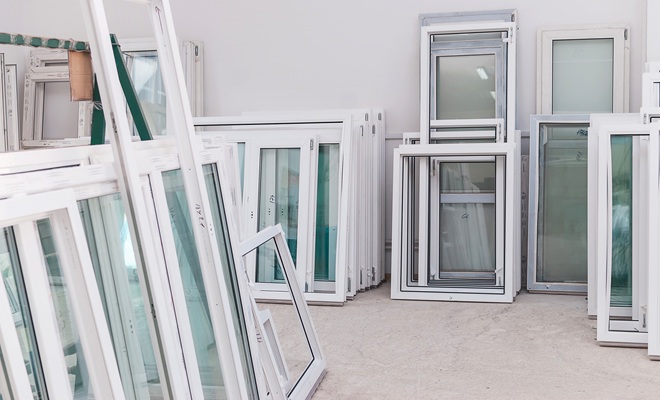
An example of how the type of window frame you choose affects the cost is that let’s compare the average price of a casement uPVC window and a timber casement window.
A UPVC double-glazed casement window with a measurement of 600 x 800 will cost, on average, between £160 and £200. If you buy the same window but in timber, then the cost will be, on average, between £400 and £500.
Window Prices
Average cost of one medium window according to style (including installation):
| Window Style | Average Cost Of Double Glazed Window |
|---|---|
| Casement | £200 - £500 |
| Tilt and Turn | £210 - £600 |
| Bay Window | £1,200 – £1,900 |
| Bow Window | £1,400 - £2,800 |
| Picture Window | £250 - £1,000 |
| Sash | £350 - £1,200 |
| Sliding Sash | £320 - £1,450 |
| Velux Window | £600 - £1,500 |
Window Supply and Installation Costs for Double Glazing
These costs are the average prices you can expect to pay for a window and the installation, at around £100 per window, outside London and the South East of England. Installation cost might be more or less depending on the size of the window and the complexity of the job.
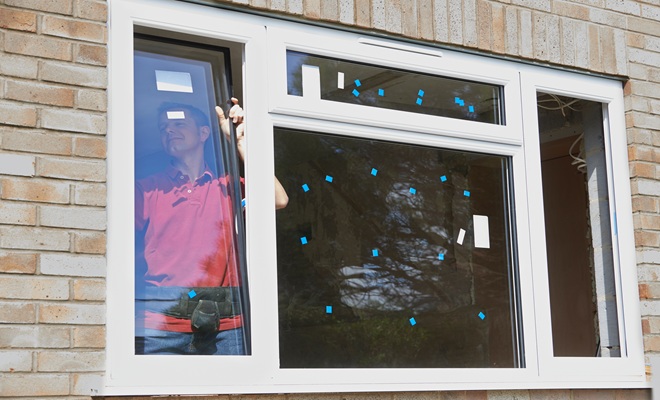
London and the southeast will be more expensive. For example, in London, the cost to buy and install a medium-sized casement window is around £500. This figure is 25% more than in other parts of the UK.
New Windows Cost - Outside London and the South East of England
| Type | Size | Frame | Average Cost Per Double Glaze |
|---|---|---|---|
| Casement | Small 600mm or less | uPVC | £285 |
| Casement | Medium 600mm – 1200mm | uPVC | £385 |
| Casement | Large 1200mm – 1800mm | uPVC | £465 |
| Casement | Small 600mm or less | Timber | £345 |
| Casement | Medium 600mm – 1200mm | Timber | £495 |
| Casement | Large 1200mm – 1800mm | Timber | £615 |
| Casement | Small 600mm or less | Aluminium | £315 |
| Casement | Medium 600mm – 1200mm | Aluminium | £440 |
| Casement | Large 1200mm – 1800mm | Aluminium | £540 |
| Tilt and Turn | Small 600mm or less | uPVC | £315 |
| Tilt and Turn | Medium 600mm – 1200mm | uPVC | £440 |
| Tilt and Turn | Large 1200mm – 1800mm | uPVC | £540 |
| Tilt and Turn | Small 600mm or less | Timber | £390 |
| Tilt and Turn | Medium 600mm – 1200mm | Timber | £495 |
| Tilt and Turn | Large 1200mm – 1800mm | Timber | £615 |
| Tilt and Turn | Small 600mm or less | Aluminium | £352 |
| Tilt and Turn | Medium 600mm – 1200mm | Aluminium | £509 |
| Tilt and Turn | Large 1200mm – 1800mm | Aluminium | £634 |
Sash Windows
| Type | Size | Frame | Average Cost Per Window |
|---|---|---|---|
| Sash | Small 600mm or less | uPVC | £345 |
| Sash | Medium 600mm – 1200mm | uPVC | £495 |
| Sash | Large 1200mm – 1800mm | uPVC | £615 |
| Sash | Small 600mm or less | Timber | £435 |
| Sash | Medium 600mm – 1200mm | Timber | £660 |
| Sash | Large 1200mm – 1800mm | Timber | £840 |
| Sash | Small 600mm or less | Aluminium | £390 |
| Sash | Medium 600mm – 1200mm | Aluminium | £577 |
| Sash | Large 1200mm – 1800mm | Aluminium | £728 |
Sliding Sash Windows
| Type | Size | Frame | Average Cost |
|---|---|---|---|
| Sliding Sash | Small 600mm or less | uPVC | £550 |
| Sliding Sash | Medium 600mm – 1200mm | uPVC | £700 |
| Sliding Sash | Large 1200mm – 1800mm | uPVC | £830 |
| Sliding Sash | Small 600mm or less | Timber | £1,300 |
| Sliding Sash | Medium 600mm – 1200mm | Timber | £1,500 |
| Sliding Sash | Large 1200mm – 1800mm | Timber | £1,700 |
| Sliding Sash | Small 600mm or less | Aluminium | £1,700 |
| Sliding Sash | Medium 600mm – 1200mm | Aluminium | £2,200 |
| Sliding Sash | Large 1200mm – 1800mm | Aluminium | £2,500 |
Velux Windows
Installing a Velux window is more expensive because the installation is more complex, and the contractors are working at height. We have added £350, which is the average cost of a contractor and an assistant for a Velux window installation.
| Type | Size | Frame | Average Cost |
|---|---|---|---|
| Velux | Small 55cm x 78cm | Polyurethane | £444 |
| Velux | Medium 94cm x 140cm | Polyurethane | £694 |
| Velux | Large 134cm x 140cm | Polyurethane | £778 |
| Velux | Small 55cm x 78cm | Pine | £427 |
| Velux | Medium 94cm x 140cm | Pine | £648 |
| Velux | Large 134cm x 140cm | Pine | £758 |
Bay Windows
Bay windows typically come in 3, 4 or 5 panels, so that’s what we’ve used here. Larger houses might have more panels, but the costs below are for a typical UK home with a bay window.
| Type | Size | Frame | Average Cost |
|---|---|---|---|
| Bay | 3 Panel | uPVC | £1,220 |
| Bay | 4 Panel | uPVC | £1,785 |
| Bay | 5 Panel | uPVC | £2,350 |
| Bay | 3 Panel | Timber | £2,175 |
| Bay | 4 Panel | Timber | £2,550 |
| Bay | 5 Panel | Timber | £2,950 |
| Bay | 3 Panel | Aluminium | £2,000 |
| Bay | 4 Panel | Aluminium | £2,350 |
| Bay | 5 Panel | Aluminium | £2,750 |
Bow Windows
| Type | Size | Frame | Average Cost |
|---|---|---|---|
| Bow | 4 Panel | uPVC | £1,800 |
| Bow | 5 Panel | uPVC | £2,250 |
| Bow | 6 Panel | uPVC | £2,700 |
| Bow | 4 Panel | Timber | £2,600 |
| Bow | 5 Panel | Timber | £3,250 |
| Bow | 6 Panel | Timber | £3,900 |
| Bow | 4 Panel | Aluminium | £2,300 |
| Bow | 5 Panel | Aluminium | £2,875 |
| Bow | 6 Panel | Aluminium | £3,450 |
Picture Windows
| Type | Size | Frame | Average Cost |
|---|---|---|---|
| Picture Window (Fixed) | 625mm x 895mm | uPVC | £704 |
| Picture Window (Fixed) | 1045mm x 1245mm | uPVC | £1,345 |
| Picture Window (Fixed) | 1245mm x 1195mm | uPVC | £1,248 |
| Picture Window (Fixed) | 625mm x 895mm | Timber | £1,053 |
| Picture Window (Fixed) | 1045mm x 1245mm | Timber | £1,591 |
| Picture Window (Fixed) | 1245mm x 1195mm | Timber | £1,833 |
| Picture Window (Fixed) | 625mm x 895mm | Aluminium | £923 |
| Picture Window (Fixed) | 1045mm x 1245mm | Aluminium | £1,345 |
| Picture Window (Fixed) | 1245mm x 1195mm | Aluminium | £1,384 |
Double and Triple Glazing Costs
If you want to install triple glazing, then you can expect to pay 10% to 20% more than the cost of double glazing. For example, a triple-glazed casement window in uPVC will cost between £342 and £558 per window, depending on the size.
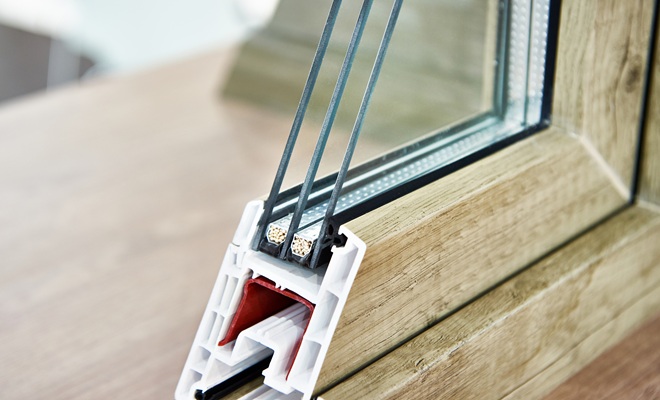
While we’ve given costs for individual window instalment, most people will have the windows replaced throughout their home. Here are some average costs for Upvc double-glazed casement window replacements in various-sized properties.
| Property | Type | Number | Time | Double | Triple |
|---|---|---|---|---|---|
| Flat | Casement Upvc | 4 Windows | 1 Day | £1,600 | £1,975 |
| 2 Bed Terraced | Casement Upvc | 8 Windows | 1-2 Days | £3,200 | £4,200 |
| 3 Bed Semi Detached | Casement Upvc | 9 Windows | 1-2 Days | £3,600 | £4,700 |
| 4 Bed Detached | Casement Upvc | 12 Windows | 2-3 Days | £5,250 | £6,175 |
If you don’t need to replace the frame but you want to fit new double glazing, then your costs will be a lot less. An average-sized window of 800mm x 1000mm will cost, on average, £72 for the glass plus £45 for installation, bringing the total to £117.
If you can’t have double glazing, perhaps because you live in a listed building, then another alternative is to install secondary glazing.
Secondary glazing means you have an extra set of glazing installed on the inside of an existing window. The average cost per window is usually between £250 and £500.
Types of Window Opening
Another factor that can have a bearing on the type of window you choose is the opening. There are several types of window openings available, depending on the type of window you have.
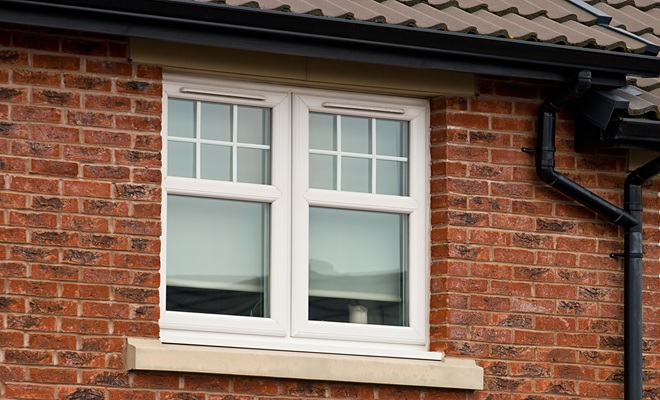
Here are some of the window openings you can choose:
Fixed Window
A fixed window doesn’t open. It is common for a picture window to be fixed because they are usually large in size.
Side Hung
One of the most common window types is a side-hung casement window. The window opens from the side and comes as a single or double window.
Top Hung
A top-hung window has its hinges at the top, and it opens by using a handle at the bottom. They are often found on casement windows.
Bottom Hung
A bottom-hung window has hinges at the bottom and opens from the top. In a house, you’ll commonly see them on upstairs windows.
Double Hung
Double-hung window openings are often seen on sash windows. This means that both the top and the bottom windows can be opened.
Single Hung
Again, you’ll see this opening on a sash window where only one pane slides open, and the other is fixed.
Tilt and Turn
Tilt-and-turn windows are popular because they are so flexible. The windows have hinges at the top and the bottom. If you don’t want the window to be fully open but you want ventilation, then you can tilt it inward, which opens the top part of the window only.
Sliding Window
Sliding windows open by sliding along a track. If you have a double window, you can slide open one or the other, or you can slide both panes to the middle of the track and create an opening on either side of the window.
Additional Costs
When you have new windows installed, you might also incur some additional costs. Here is a list of the extra expenses you might have to add to your budget:
Scaffolding
If the upstairs windows are being installed from the outside, then it will be necessary to erect scaffolding so that the window installers can do their job safely. You will either need a scaffolding tower or full scaffolding, depending on the number of windows being installed and the ease of access.
The average price for a scaffold tower is between £250 and £300 a week. Full scaffolding can cost between £800 and £1,000 on a semi-detached property. Costs will be higher if you live in London or the southeast of England.
Cleaning Gutters
While you have your scaffolding in place, you may also want to have your gutters cleaned and your roof inspected for damage. The cost of cleaning your guttering will be an average of between £75 and £150, depending on the size of your property. In addition, you’ll need to add the costs of labour.
Between 15 and 20 meters of guttering will cost, on average, between £100 and £250. That will bring the total cost of cleaning your guttering to between £175 and £400.
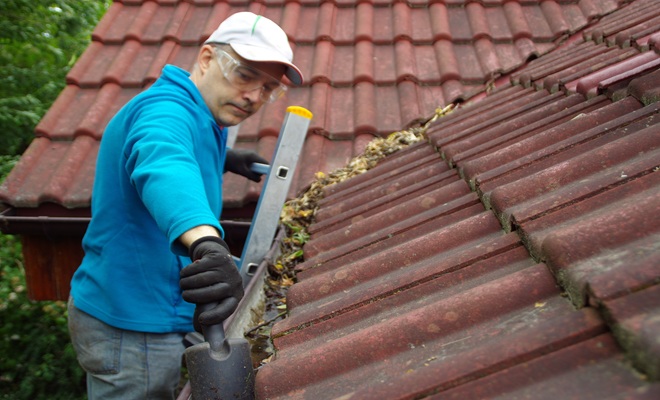
Window Frame Repairs
If you keep your original window frames and update the glazing, then you might have to add the cost of window frame repairs to your budget. The cost will depend on the material of the frame you have, the size of the window, and the type of damage that needs repair.
The average cost of repairing a uPVC window frame is between £150 and £370. A repair to a wooden frame is, on average, between £100 and £245. Aluminium frame repairs will cost between £120 and £315.
Waste Removal
If you use a FENSA-registered window fitter, they will take the old window frames under the FENSA Recycling Scheme free of charge.
Otherwise, you can hire a skip, arrange for a person with a van to collect the glass and the old frame or take it to the tip or recycling centre yourself.
The cost of skip hire for a week will depend on the size of the skip. For example, a skip that will hold approximately 30 bin bags will cost between £60 and £130. A large skip that will hold approximately 80 bin bags will cost between £160 and £370.

A person with a van will cost anything between £30 and £90 per hour. The price will depend on where you live and the type of waste that’s being removed.
If you take your window frames and glass to a waste and recycling centre, you may be able to dispose of one glass sheet free of charge, but anything else after that will cost between £2.00 and £10.00 per item.
Upgraded Security Features
Adding window locks will, of course, enhance your security and deter burglars. You can buy window locks at most hardware stores. Prices range from £5.00 to £90 depending on the quality and material you choose. You can either install the locks yourself or hire a handy person to do the job. A handy person will normally charge between £20 and £30 an hour.
Decorating Costs
Whilst you're having new windows installed, you might decide it’s time to give the outside of your home a lick of paint. A fresh, clean exterior will improve the value of your home and make it more appealing.
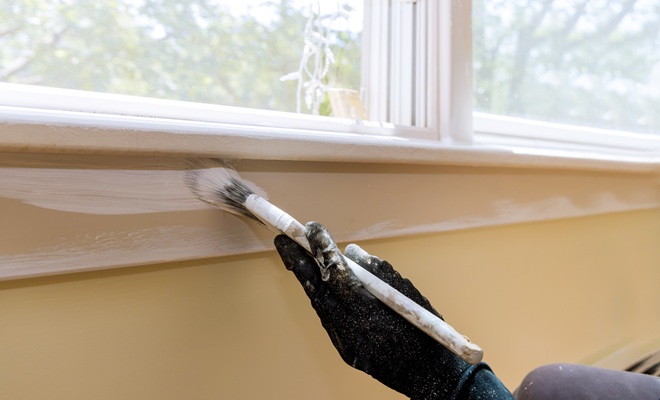
The average cost of painting the outside of your home is between £500 and £1,000, depending on the size of your property and the type of paint you use. For example, the average cost of painting the exterior of a 3-bedroomed semi-detached house will be between £700 and £1,000 and will take 4 to 5 days to complete.
Planning Permission
You shouldn’t need planning permission to install new windows unless you live in a listed building or in a conservation area. However, before you start any work on your home, it is best to check with your local planning authority. Installing skylights, for example, doesn’t need planning permission but is subject to certain conditions and limits. You can find out where to find your nearest planning authority on the Planning Portal website.
Cost Breakdown Calculator
Individual costs for replacing a fuse box with a new consumer unit with 10 MCB's - Total Cost: £450
Materials
Labour
Rubbish Disposal
Labour Costs and Time Frames
The labour costs and timeframes for window installation will depend on how easy it is to access your home, any repairs or structural work that needs doing and the weather. If you only have one window to replace, then it is likely that you’ll pay a window installer and an assistant for between 2 and 4 work. A typical hourly rate is between £20 and £40 per hour for a professional window installer and between £12 and £15 for an assistant.
The chart below gives you some average costs and timescales for various types of window instalment.
| Type | Time | Window Fitter | Assistant Window Fitter | Total Cost |
|---|---|---|---|---|
| Casement | 1-2 Hours | £20 - £40 | £12 - £15 | £32 - £110 |
| Sash | 3-4 Hours | £20 - £40 | £12 - £15 | £96 - £220 |
| Tilt and Turn | 3-4 Hours | £20 - £40 | £12 - £15 | £96 - £220 |
| Velux | 6-8 Hours | £20 - £40 | £12 - £15 | £192 - £440 |
| Picture | 4-6 Hours | £20 - £40 | £12 - £15 | £128 - £330 |
| Bay/Bow | 6-8 Hours | £20 - £40 | £12 - £15 | £192 - £440 |
Types of Windows
Casement Windows
Casement windows are very common and can be seen on many homes around the UK. Its popularity stems from its ease of installation and reasonable cost. Casement windows are usually side hung, but you can buy top or bottom hung windows in this style.
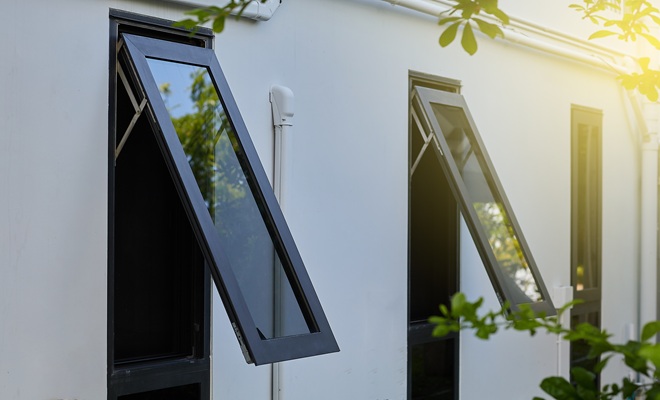
Pros
- ✔ Open outward to provide plenty of ventilation
- ✔ Very secure as they can’t be opened from the outside
Cons
- ✖ Only certain sizes can accommodate a casement window because it can’t hold a heavy frame
- ✖ Can be labour intensive to install
Tilt and Turn Windows
Tilt and Turn windows are easy to keep clean because you can open them up like you do a door. However, if you just want to air a room, then you can tilt the window, and it will open at the top. This means you can ventilate a room without having the window fully open, which provides better security.
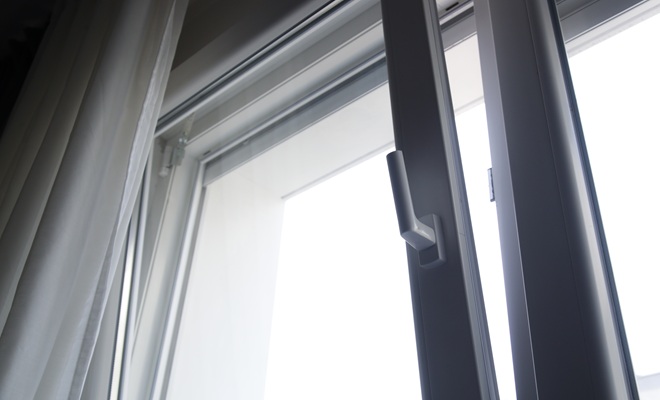
Pros
- ✔ Cleaning is very easy
- ✔ More secure than a wide-open window
Cons
- ✖ The inward tilt doesn’t let in a lot of ventilation
- ✖ More expensive than some other window types
Bay Window
Houses built in the Victorian and Edwardian eras often have bay windows, and they were also popular in the 1930s. A bay window is commonly a three-sided structure with a fixed pane of glass in the middle and two casement or sash windows at the side. They curve outwards from the property, which generally provides more space in the interior of the house.
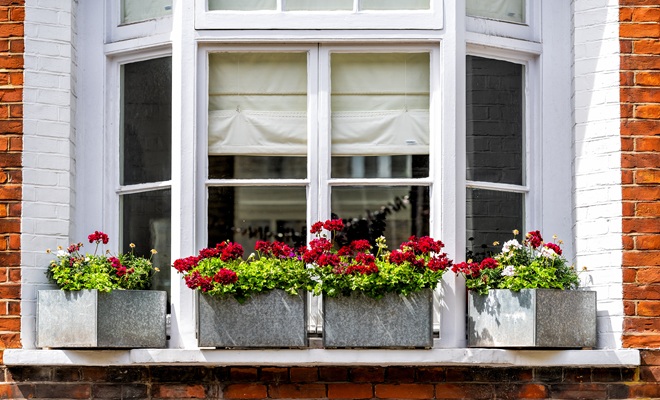
Pros:
- ✔ Creates space in the room
- ✔ Brings in more natural light
Cons
- ✖ More expensive to buy and install
- ✖ Curtains difficult to fit
Bow Window
Bow windows are similar to bay windows, but they are built with more of a curve, which is produced with four or more glazed panels.
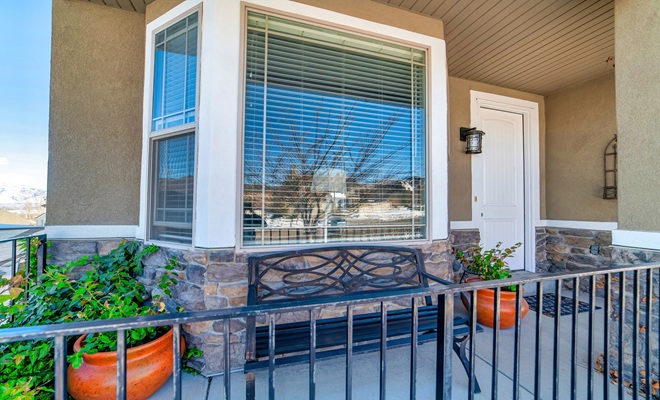
Pros:
- ✔ You have side views of the outside
- ✔ Plenty of natural light due to the number of window panes
Cons
- ✖ More expensive than a bay window
- ✖ Labour costs will be higher as the installation is more complex than a bay window.
Picture Window
A picture window is a fixed piece of glazing, so it doesn’t open. It is often large in size and used often to enhance a particular view.
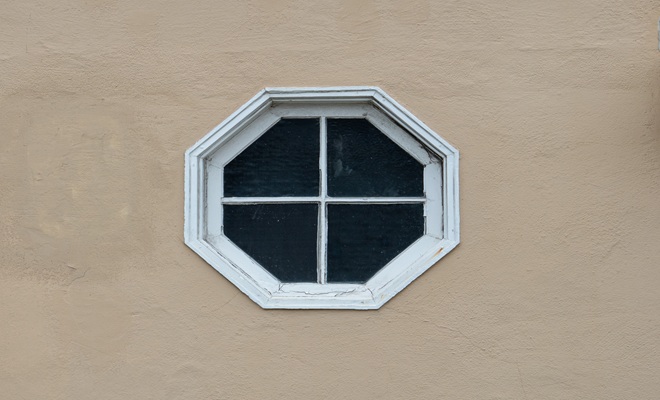
Pros:
- ✔ Enhances a pleasant view
- ✔ Can be made to measure
Cons
- ✖ Don’t provide ventilation as they can’t be opened
- ✖ Probably need cleaning professionally, especially if at an upstairs window
Sash Window
Sash windows don’t have hinges. Instead, they open by sliding the window up or down. They are popular with householders who own Victorian or Georgian properties
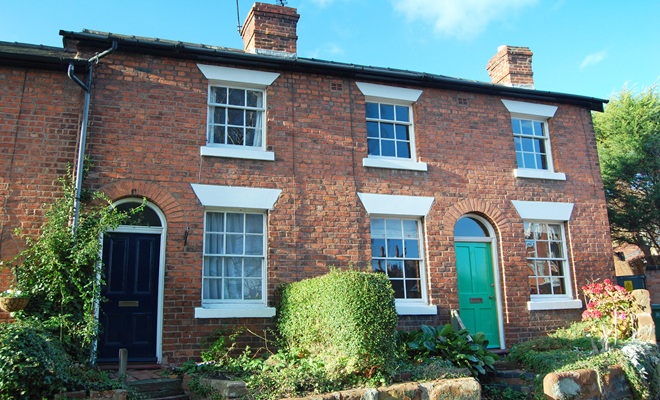
Pros:
- ✔ They can open at the top and the bottom, creating better air flow
- ✔ The window can be locked slightly ajar to bring in air without compromising security
Cons
- ✖ More expensive than casement windows
- ✖ Cannot open fully, making cleaning more difficult
Sliding Sash Window
A sliding sash window is one which is opened by sliding it to the side like a door you might have leading out to a patio or garden. They are popular in modern homes.
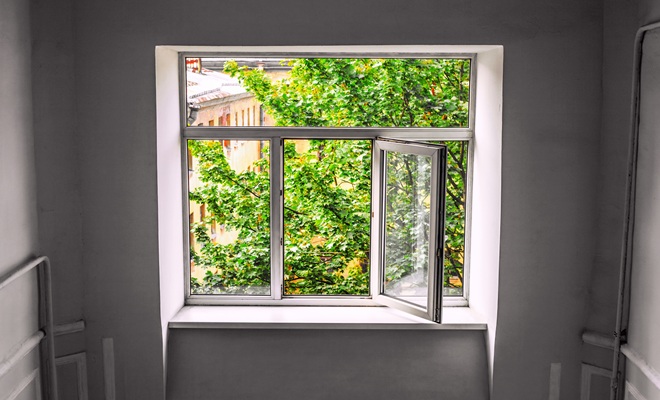
Pros
- ✔ uPVC sliding windows need minimal maintenance
- ✔ Available in a wide range of styles and colours
Cons
- ✖ It can’t be fully opened
- ✖ Difficult to paint if you have timber frames
Velux Windows
Velux windows are installed in the roof or in the case of a dormer window with a slight protrusion. You will commonly see them where there is a loft extension.

Pros:
- ✔ The ideal solution in a loft
- ✔ Brings in plenty of natural light
Cons
- ✖ Cleaning may be difficult
- ✖ Blinds for Velux windows can be expensive
Secondary Glazing
Secondary glazing fits behind the glass in an existing window and is often used by householders with period properties or who live in listed buildings and are unable to have double glazing.
DIY Window Replacement Vs Professional Installation
The DIY Route
A person who is competent at DIY might want to fit their windows, and it is possible. But there are some considerations to think about before you start.
Firstly, the measurements for a window must be accurate; otherwise, the frame won’t fit properly, and any savings you were hoping to make will literally be out the window as the heat from your home escapes through the gaps.
Another consideration involves building control. If you do the work yourself, you will have to obtain approval from your local council’s building control department, including filling out and paying.
They will visit your home when the work is complete to make sure your installation is up to standard. If it is, then they will sign off the work, but if it isn’t, you will either have to repeat the process according to building control standards or pay a professional to redo the work.
However, if you are competent at DIY, there is one job you can do yourself to save money. Before your new windows are fitted, the old windows need to be removed. You will only need a screwdriver, hammer and chisel to do the job. This might save you between £20 and £35 per window.
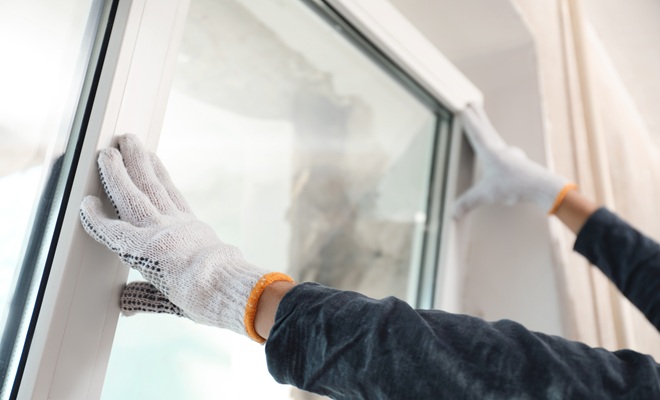
Hiring a Professional
If you want someone with experience and skill to fit your windows, then you are better off hiring a professional. A window fitter who does the job every day will accurately measure windows, install them quickly and provide a guarantee.
If you hire a FENSA-registered contractor or a window installer with CERTASS, you won’t even need an inspection from building control. FENSA and CERTASS-registered window fitters are recognised under the Competent Persons Scheme. They can sign off on their own work and give you a certificate of installation that complies with building regulations and is registered with your local council. However, only FENSA have a recycling scheme for old windows.
Building Regulations and Compliance
New windows do have to comply with building control regulations. This means you have to contact your local building control department and fill out a Replacement Window and Door Application form. There is a fee payable. Costs depend on your local authority, but on average, they are between £150 and £200, which includes a site visit to inspect the work once the windows have been installed.

Cost of Removing Old Windows
Some window companies include the cost of removing your old windows in the price they quote for new windows and installation. An independent window installer is also likely to include a price for the removal of old windows before installing new ones. The cost will depend on how many windows need to be removed. On average, you should expect to pay between £20 and £35 per window removal.
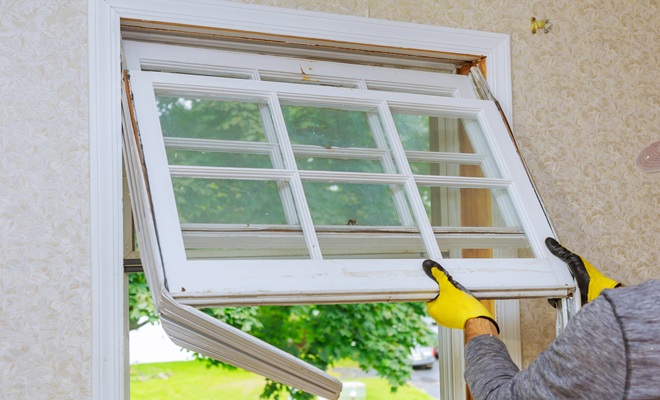
FAQs
Finding and Hiring a Professional
Find professional window fitters or joiners online by looking at trade directories such as priceyourjob.
Otherwise, ask around. Friends, neighbours and work colleagues will often have a recommendation of someone they have used in the past. It’s best to get at least 3 quotes for the same job. Make sure they include the same job specification so that you can easily compare each quote.
If you want to use a window installer who is a member of a trade association, then ask them to show you their registration cards and make sure they are up to date. You should also find out whether they are registered in the Competent Person Scheme, as this will save you from having to have a building control inspection when your windows are installed.
Another check you should make is to find out what insurance the contractor has while working. They should have a minimum of Public Liability Insurance, and if they employ staff, they should also have Employer’s Liability Insurance. These cover legal costs should they arise if someone is injured or property is damaged while they are working at your home.
Also, ask each builder that gives you a quote about their experience and whether they have feedback or recommendations from previous customers. They may answer that they have a website with customer testimonials and photographs, which you can then look at online.
Finally, make sure you get your quotes in writing, either on paper or by email.









